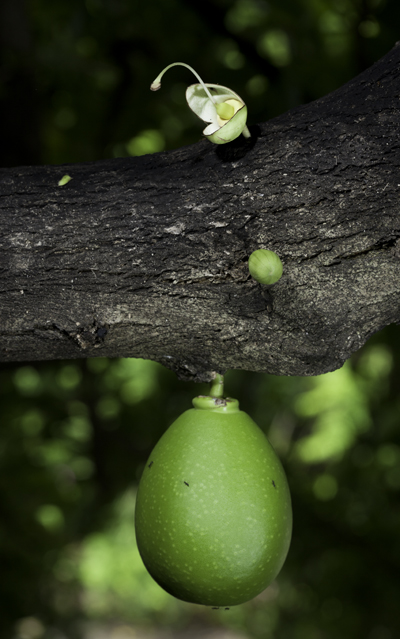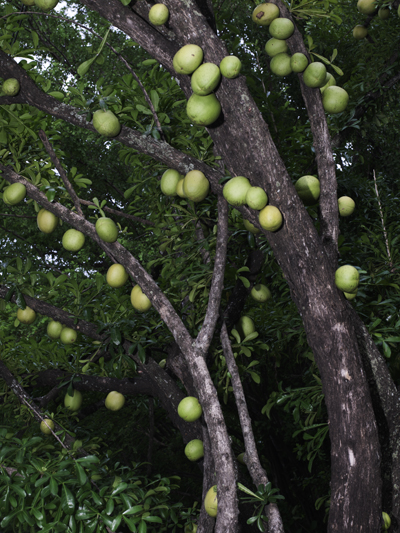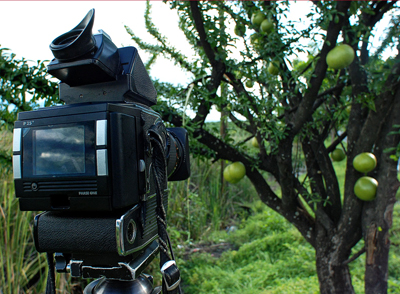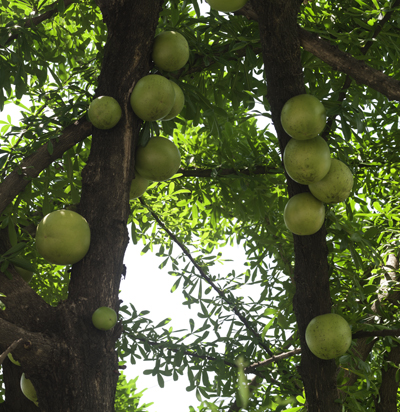The calabash tree is featured in the Mayan mythology of the Popol Vuh. So the calabash (morro or jicara) is important for studies of Mayan iconography, religion, and ethno-botanical part of ethnography.
The Classic Maya of Peten and adjacent lands used the morro and jicaro for drinking cups, for drinking cacao (chocolate). Indeed most Peten-area Tepeu 1 Mayan bowls of fired clay were modeled after drinking cups made by hollowing out the seed pods (fruits) of either morro or jicara.
 |
|
Morro small oval fruit above string bud, August 2011. |
Of these two species, one has round fruits almost always; the other species can have both round and oblong on a single tree. Trees in the Rabinal area, however, are bread for very specific use, so one species is primarily globular; the other species is clearly enlongated.
 |
|
Photographing Morro in Rabinal, Baja Verapaz, Guatemala August 2011. |
We show photographs of all the fruits of this tree in our new web site on Maya-ethnobotany, namely www.Maya-ethnobotany.org. You will notice a lot of focus at FLAAR on the morro and jicaro (also spelled and pronounced jicara). The focus is because there have not really been any Maya ethnobotanical studies that clearly define the two trees, that show the similarities and yet differences. Indeed it has taken me four years to figure out how to recognize the difference in the trees (because the fruit of both can be round; the tree that is supposed to have oblong-shaped fruit often has fruit that is perfectly round and spherical).
So we will be issuing many many reports over the coming months on both Cresentia alata and Cresentia cujete. Morro and jicaro are local names; used often indiscriminently. In other words, two different people may use a different name for the same tree. And some people use one of the names for both trees. This is typical in Hispanic nomenclature of plants, fruits and some animals. Nomenclature in this part of the world is a tad informal.
The other reason we focus on these two trees is because most archaeologists and iconographers do not have personal experience with them, or at least not to allow them to tell the difference. And I bet 100% of the major epigraphers, iconographers, and archaeologists working in the Maya area are not aware that there is a third species (actually a different genus). And that this third tree has a fruit that looks very very much like a cacao pod! I include myself in the 100% of Mayanists who had no idea about the cacao-look-alike that was a relative of the calabash tree.
Now that I am familiar with this third tree, I have found it in Monterrico, Jardin Botanico in Guatemala City, and in Sayaxche (it was behind the table where I was seated for breakfast). Cesar (a capable member of our team for many years) spotted it and pointed it out to me. He knows all the plants we are looking for, and tells us which species are available in our surroundings.
We cover morro and jicaro in two web sites: the botany on our ethnobotany site, and the artifact aspect on our Maya archaeology site where you are now. So lets look at jicaros and morro as material to make artifacts (drinking cups and musical instruments).
 |
|
Morro tree on the edge of the road, July 2011. |
 |
|
Morro fruits in tree on the edge of the road, July 2011. |
Chinchines, guacales, jicaras, alcancillas, llaveros: morro and jicaro
Several years ago the botany student who worked with us at that time, Anaite, told us about a local Maya woman in Rabinal who used jicaros and morro for making handicrafts. So we visited this lady at that time. Unfortunately those photos are can’t find (no surprise since we have zillions of digital images). So this year, 2011, we returned to the village. It happened that the sister was the one who answered her phone first, so for this new visit we visited the sister, Olga. Both live on the same street, separated by about 70 meters from each other. They are completely separate entities, different company in each case.
 |
|
Photographing Morro with a Hasselblad + Phase One digital back, July 2011. |
Olga Garniga and her family make the chinchines for local music, as well as guacales, alcancillas, cups and bowls, llaveros: all out of the rigid husk of morro and jicaro fruits.
Using a lac-like insect to make lacquer
Of everything which I saw and experienced during a long day in Rabinal, the most interesting was the insect used for a lac-like preservative. They called this a niij, or cochinilla. We will discuss this insect in detail on our forthcoming web site, www.maya-ethnozoology.org, which we hope to launch this autumn.
A field with both morro and jicaro is next day
A small enclosed field with healthy morro and jicaro trees is next door. Since this field has both species next to each other it is easier to see the difference between Cresentia alata (morro) and Cresentia cujete (jicara).
Just realize that you can call one jicara or jicaro. Some people use the same or different words for both species. What counts is the color of the flower: the fruit which is round all the time has a light green “white” flower. The fruit of the other species, which can have a fruit that is round, or oblong, is dark maroon color.
We show dozens of examples on our new www.maya-ethnobotany.org.
The FLAAR Photo Archive has the largest digital photographic archive in the world of these two flowers and their resulting fruits.
 |
|
Morro fruit in Rabinal, Baja Verapaz, Guatemala August 2011. |
Contact information for morro and jicaro
Olga Garniga Osorio
La Maravilla del Morro
9a Avenida Final, Zona 2
Rabinal, Baja Verapaz, Guatemala, Central America
Telephone (502) 5124-5339
First posted August 12, 2011.






























